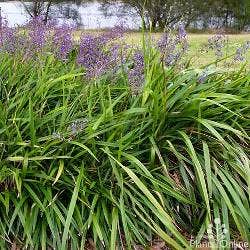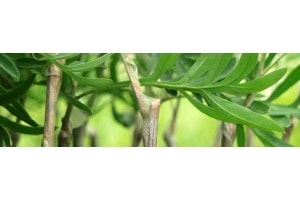
Do You Dig Our Dianellas?
 Dianellas – our native flax lilies – are an excellent addition to all kinds of gardens, from native bush paddocks to schmick urban back yards.
Large-size native flax lily plants are ideal for easy container planting, or as a feature plant in a border, especially the more ornamental forms with striped or coloured leaves.Small-size native flax lily plants are ideal for living groundcovers, and planting between larger shrubs.
Dianellas – our native flax lilies – are an excellent addition to all kinds of gardens, from native bush paddocks to schmick urban back yards.
Large-size native flax lily plants are ideal for easy container planting, or as a feature plant in a border, especially the more ornamental forms with striped or coloured leaves.Small-size native flax lily plants are ideal for living groundcovers, and planting between larger shrubs.
Easy to grow & maintain
Because flax lily plants are compact, they also make excellent edging for borders, driveways, paths and lawns, where they will need very little care and maintenance. As low-maintenance ground cover , beneath seasonally flowering shrubs, they help cool the soil and keep weeds at bay.
 Some flax lilies are happiest growing in shade – alongside a house wall, or under a tree.
Some flax lilies are happiest growing in shade – alongside a house wall, or under a tree. While other flax lilies perform best in full sun, often in difficult locations where other plants might struggle.
There are Dianellas that will grow in rich moist soils, and ones that will grow in dry sandy soils. Ones that thrive in humidity, and ones that survive harsh frosts. On the whole Dianellas are supremely easygoing and very tolerant of all kinds of conditions.
Dianellas look impressive in mass plantings, especially when in full flower; use them solo, or mix them in with complementary grassy plants like liriopes, lomandras, and mondo grass.
Ornamental leaves & berries
 Their evergreen foliage makes an impressive elegant shape, rounded and self-contained. The long strappy leaves often form a natural fountain, emerging from a central point in a soft cascade. The strong leaves were used by Aboriginal peoples to make baskets and bags, and are still used in this way, also by artists, to create functional and sculptural woven items.
Their evergreen foliage makes an impressive elegant shape, rounded and self-contained. The long strappy leaves often form a natural fountain, emerging from a central point in a soft cascade. The strong leaves were used by Aboriginal peoples to make baskets and bags, and are still used in this way, also by artists, to create functional and sculptural woven items. The leaf colour is one of the attractions of the plants, as it can be vivid bright green, soft blue-green, white striped, purple-grey, and red-stemmed, depending on the variety. In spring and summer, Dianellas develop long slim flowerstems, held proud of the foliage, which carry spires of tiny star-shaped blooms like those in the image.
 In shades of purple, lavender and blue with golden centres, the flowers hang suspended on slender stems. The slightest breeze sets these sprays of flowers gently bobbing and swaying.
In shades of purple, lavender and blue with golden centres, the flowers hang suspended on slender stems. The slightest breeze sets these sprays of flowers gently bobbing and swaying.These flowerstems can be trimmed off after flowering to keep the plant tidy, and encourage more growth in the leaves; but it's not essential. If the flowering stems are left on the plant, they develop into clusters of unmistakable bright blue-purple glossy berries, adding welcome colour to an autumn garden. Several species are reportedly edible as bushtucker (see below for more details) and all are fantastic for flower arranging too.
Which Dianella Is For You?

Dianella caerulea
D. caerulea originates from the eastern states and Tasmania, and is tolerant and easygoing of most garden situations. Plants are long-lived, frost-hardy, and grow in a range of soils, from sandy to seasonally wet. The species has dark green leaves and blue spring-summer flowers, followed by deep blue-purple berries. The berries are edible bushtucker - though we advise to be absolutely sure of the variety if you chose to eat them.D. caerulea Little Jess™ : 20cm. Very tiny and dainty, broad leaves, tiny purple flowers, very drought tolerant and frost tolerant. D. caerulea Emerald Fountain : 40cm. Brighter leaf colour, deeper purple flowers, frost tolerant, longlived. Our most popular flax lily D. caerulea Cassa Blue : 50cm. Broader leaves with a slight twisting movement, beautiful blue-purple steely colour
Dianella revoluta
D. revoluta is widespread across all Australian states except NT, and found in a range of locations from very wet, to winter frost, to hot and dry. The species is compact, with short slender leaves and blue-purple spring-summer flowers, followed by blue-purple berries.D. revoluta Petite Marie PBR : 30cm. Bright blue flowers, bushy, small, and mat forming. You can see this one in the banner image at the top.

Dianella brevipedunculata
D. brevipedunculata originates from eastern states, predominately southern Queensland, and is happy in warm humid climates. The species has green leaves which are long, often cascading or folding in habit, and purple blue spring-summer flowers, followed by deep purple-blue ornamental berries. The berries are harmful if eaten.D. brevipedunculata : to around 50cm. Lime-apple leaves with contrasting dark margins along the base of stems, compact dark purple-yellow flowerspikes. This is the species form, so it is suitable for wildlife, Landcare, and revegetation planting.

Dianella tasmanica
D. tasmanica originates from Tasmania, unsurprisingly, and is also found in the south-east mainland. It is frost tolerant, salt tolerant, and very tolerant of wet conditions. Plants enjoy shade, cooler climates, and regular water. The species is tall, with long green leaves and blue spring-summer flowers, followed by large ornamental purple berries. The berries are poisonous, which is why accurate identification is important.D. tasmanica Silver Streak : 50cm. Variegated white margins on the leaves, great mass planted. Prefers a moister soil than others to keep looking good. You can see this one at the top of the page D. tasmanica Cherry Red PBR: 75cm. Wide arching dark bottle green leaves, larger size flax lily all around, with bright red stem bases. More tolerant of wet and humidity than other Dianellas.
How many Dianellas could you make room for in your garden?


















